Samsung Galaxy Nexus & Ice Cream Sandwich Review
by Brian Klug & Anand Lal Shimpi on January 18, 2012 1:34 PM ESTBattery life remains the other big axis on which smartphones are judged, and here we've turned to our regular 2011 suite of battery life tests to see how the Galaxy Nexus shakes out. Our battery life testing consists of a page loading suite which loads through a few dozen pages endlessly on both WiFi and cellular data until the phone dies, with the display set at 200 nits. For the cellular tests, we're always careful to test in cellular environments with decent signal (at least -75 dBm or higher) as well, since that's a factor. Next is a simple call test where we play music at both ends of a call until the device under test dies, and our final test is a WiFi hotspot workload which consists of four page loading tabs and a 128 kbps streaming MP3 station that runs until the phone dies.
First up are the web browsing tests over cellular 3G; this means EVDO Rev.A for the CDMA/LTE version, and WCDMA T-Mobile for the GSM/UMTS device.
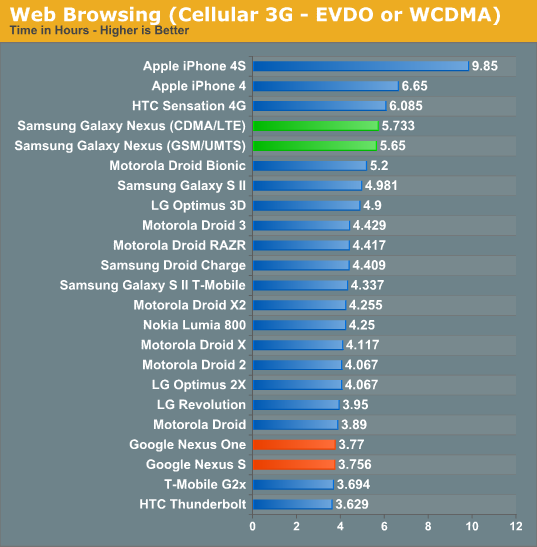
The Galaxy Nexii both do surprisingly well. I'm actually very impressed with how long the devices lasted subjectively on 3G and this definitely backs that up. Of course, both devices include beefy batteries, but Samsung has done a nice job thus far including big batteries without making devices bulky or heavy.
Next up is the same test, but on 4G LTE for the CDMA/LTE variant.
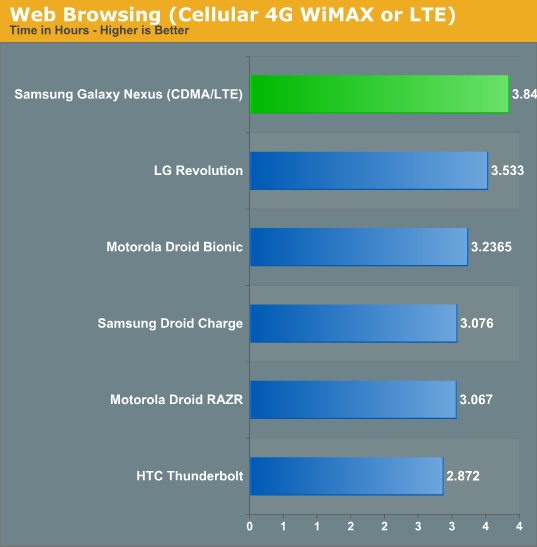
The Galaxy Nexus doesn't post numbers very far in front, but manages to come in the top of the pack on 4G LTE at just under 4 hours. This is a pretty impressive result, honestly, considering that CMC221 is likely made on the same 45nm manufacturing process as CMC220. Again, I'm impressed with the Galaxy Nexus' longevity even on 4G LTE.
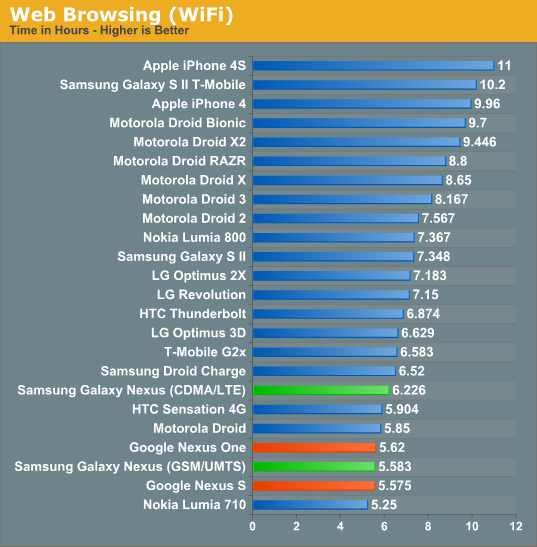
Surprisingly, the Galaxy Nexus can't break past that 6 hour mark even on WiFi, however, which does lead me to think we might be constrained by driving that display.
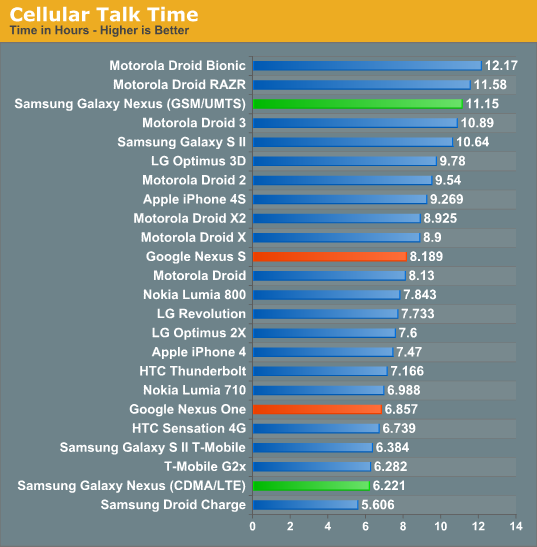
If you ever wanted to see how much difference having a different cellular architecture makes, see above. The GSM/UMTS Galaxy Nexus lasts impressively long on a voice call, at over 11 hours, yet its CDMA/LTE brother lasts just over half that.
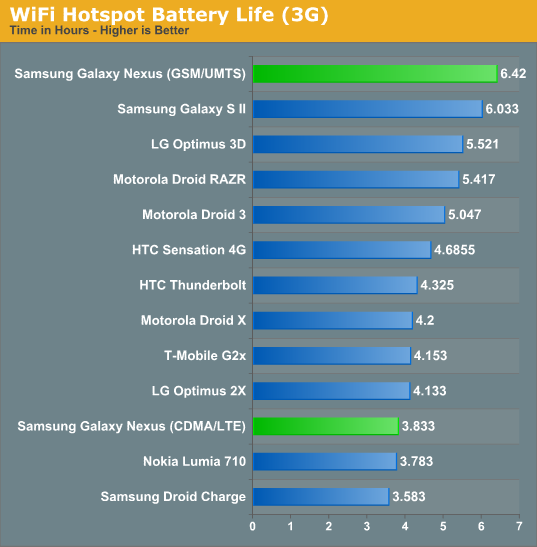
WiFi hotspot on 3G tells the same story - I'm not sure what Via Telecom's CBP7.1 draws in its active state for EVDO or 1x voice, but it seems to eat up more power than the XMM 6260 (X-Gold 626) in the GSM/UMTS Galaxy Nexus.
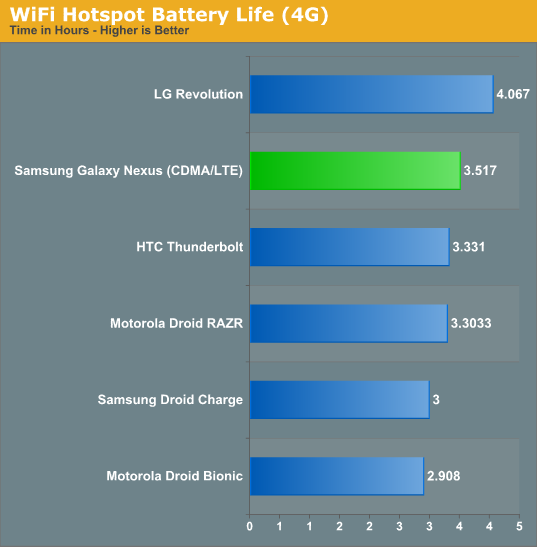
As a 4G LTE WiFi hotspot, the Galaxy Nexus loses its edge over the Revolution, but does come in just ahead of the rest of the 4G LTE herd.
The story of battery life on the Galaxy Nexus unsurprisingly depends on which variant you're talking about. For a phone with a 4.65" display, I'd say I'm impressed with the battery life on both devices - remember that the area that needs to get lit up goes as r^2 - increasing that and not killing the battery is a big feat. In addition, I'd wager that using the OpenGL ES renderpath (and accelerated browser in 4.0) definitely helped both Galaxy Nexus devices post impressive scores. As for the two variants, the GSM/UMTS device has impressively long battery life pretty much across the board. Playing with that phone, I was rarely wanting for more on my regular use schedule (I charge at night on my nightstand). We've seen XMM6260 before in numerous devices where it seems to be a pretty good citizen.
The CDMA/LTE variant, on the other hand, depends strongly on what air interface you end up using most - on 4G LTE the device comes in at the front of the pack usually, and its 3G web browsing test is above average. However, if you make a lot of voice calls, the phone might not cut it. Unsurprisingly the CDMA/LTE Galaxy Nexus does nothing to dramatically change 4G LTE battery life - for that we're still waiting for upcoming 28nm LTE basebands.










185 Comments
View All Comments
sjankis630 - Wednesday, January 25, 2012 - link
I can comment that my Galaxy Nexus' black is as black as midnight to a blind man.The only time I see some grey type tones is when the website is colored that way.
walkman - Sunday, January 22, 2012 - link
That was a shocking detailed and informative review -- It's the sort of article that makes Anandtech my first choice for tech reviews.- The article mentioned new processors just around the corner. Was this referring to any processors other than Krait? I haven't heard any news about Krait since November PR -- Are we looking at April or June? And do we think anyone besides HTC will use Krait?
Omid.M - Sunday, January 22, 2012 - link
Processors around the corner:Krait
Tegra3
OMAP5
Exynos 5250
It's going to be a bloodbath for the next 12-18 months.
If iPhone 5 uses the MDM9160 (?) modem with LTE, I'm jumping on that. Tired of tweaking battery life on my Thunderbolt. Not sure I want to do the same with a Galaxy Nexus LTE.
And what's this I'm reading about connection issues / dropped calls on the VZW Nexus? Ridiculous.
Rictorhell - Monday, January 23, 2012 - link
I am a big fan of this site and I read the reviews and articles all of the time and I find them very informative and useful, but, I have a request.When a review is written, particularly about a certain smartphone or tablet, it is mentioned whether the device has an SD card slot and you always tend to differentiate between whether it is a “full-sized” SD slot or a “micro”SD slot. That is useful to know, but there are several actual types of SD cards available, each with a different maximum storage capacity, and you don't specify in your reviews which types of SD cards are actually supported by the device being reviewed and I think that is a bit of an oversight.
To the best of my knowledge, standard SD cards only have a maximum capacity of up to 2gb, while SDHC cards can go up to as high as 32gb, and SDXC cards, while only available right now in sizes up to 128gb, are supposed to theoretically be able to be manufactured in sizes up to 2tb.
There is a huge difference in size between 2gb, 32gb, and 128gb. Given that smartphones and tablets have substantial built in limits as far as storage capacity, I think it would be very helpful to know which type of SD card is supported by which device, if that is possible.
If I read two reviews about two different Android tablets and both reviews mention that both cards have a full-size SD card slot, as a user with a lot of media files, I'm going to be interested to know if one of those tablets can support SDXC cards while the other one cannot.
I consider that to be a major feature, to me, just as important as battery life. If you do reviews of tablets and smartphones, or even ultrabooks, and neglect to specify how much storage potential these devices have or do not have, you are making it very easy for the hardware manufacturers to simply put in second rate storage and format support, knowing that it will not be covered in reviews by sites like Anandech. Not only is this going to stunt the evolution of these devices but it's also going to mean less options for consumers.
Anyway, thank you for your time.
peevee - Tuesday, January 24, 2012 - link
Anand, please include OS version number (and carrier when applies) in the charts for performance and battery life tests. They make huge difference, as browser speeds improve, they consume less CPU time and less energy when browsing.For example, the discrepancy between iPhone 4 and iPhone 4S looks outsized and probably is the result of testing iPhone 4 with iOS much older than the current version, probably not even 4.3, and 4S with iOS 5.
skinien - Tuesday, January 24, 2012 - link
What a review!!! I'm not in the market for a new hone right now, but when the time comes, I'll be looking here for a review on prospective phones. GREAT WRITE UP!sonicmerlin - Thursday, January 26, 2012 - link
I'm sorry, but you're ignoring the fact that ICS STILL lags. If you load up a heavy site like theverge, try scrolling around while the site is loading. Your entire page stutters and freezes until everything is done loading. ICS also lags more as you load more apps onto your phone, just like all previous versions of Android. Also notice how all UI elements are flattened when pages are rendered. Try zooming in or out. The new page info appears all at once, rather than pop up individually as in iOS and WP7. This can result in lag on heavy sites.For whatever reason tech "nerds" don't seem to notice the very obvious fluidity issues. Yes once you've loaded up a site it's easy to pan around, but people don't sit there patiently waiting for websites to load. Nor do they appreciate the frequent microstutters due to garbage collection issues, or the massive standby battery drain issues that tons of Android phones experience. And even the basic phone UI itself still lags behind your finger, demonstrating an irritating rubberband affect.
It's stupid. Android will never stop lagging until Google rewrites the OS to give the UI thread priority, instead of putting it at the same level as app priority.
rupert3k - Friday, January 27, 2012 - link
Learned loads from reading this, really impressed with how far Android has come.The stuttering when scrolling, zooming or browsing always annoyed me, stoked to learn ICS is fully accelerated.
One wonders if we'll see any Motorola Nexus style devices once Google settles into their new ownership. Be nice to see a Motorola this nice!
Hope we see high dot pitch Android devices to combat Retina, not happy with AMOLED at present it seems a bit yellowy & over saturated to me, surely LG or Samsung can also spec Retina style IPS or at least offer the choice between AMOLED & IPS 330dpi.
Bring on the Quad high DPI Android & iOS tablets!!
bruce3777a - Sunday, January 29, 2012 - link
Hi,Please bear with me:)
If a phone was upgraded from Gingerbread to ICS and It appears to be able to still work with the apps from many banks
It seems like these apps were not compatable with tablets running honeycomb so it was necessary to just use the browser.
If a tablet is upgraded from Honeycomb to ICS, or if a new tablet is purchased that has ICS would/should that automatically make it compatable, or is there still something that the banks would need to do to make it universal to both phones and tablets that use ICS. Thanks in advance for any insight.
Lucian Armasu - Monday, January 30, 2012 - link
I think I figured it out. I just saw this:http://score.nena.se/nenamark/view?version=2&d...
And I remembered it's not the only time I see 1196x720 pixels being rendered in a benchmark. Anand, if you're reading this, could it be because the buttons are NOT rendered by the GPU, and instead are rendered by those Cortex-M3 2D cores? They would have to render much fewer pixels, but they are also much slower than the GPU, and also pretty old tech I think.